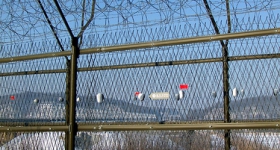Originally posted at New America Media.
by
Only weeks after the San Jose Police Department (SJPD) announced the addition of two federal immigration officers, officials say they are now considering participation in a new program calling on local police and residents to report to the FBI, Homeland Security and a host of other federal enforcement agencies.
Participation by local police departments in the Suspicious Activity Reporting Initiative is optional. In advance of making a final decision, SJPD Chief Chris Moore held a forum at Pioneer High School for community representatives and city officials to learn about the program from federal officials and give input on San Jose’s potential involvement.
The City of San Jose, having recently appointed Chief Moore, is trying to rebuild trust between local law enforcement and ethnic communities after a couple of high-profile use of force cases, and allegations of racial profiling that culminated in a city taskforce and changes to downtown policing policies in 2010. Due to budget cuts, the SJPD recently laid off over 100 police officers, and repeatedly messaged that they need closer partnerships with community groups to maintain public safety in a time of depleted resources.
The department’s recent decision to bring US Immigration and Customs Enforcement (ICE) officers to the department through a Homeland Security program called Community Shield, has set off a firestorm of controversy among immigrant-service organizations. Some community representatives, as well as national civil rights advocates, contend that involvement in the federal surveillance program will further undermine trust-building efforts.
Observing Suspicious Behavior
Material provided by the federal agencies at the Pioneer High forum, describe the initiative by stating, “Every day, law enforcement officers at all levels of government observe suspicious behaviors or receive such reports from concerned civilians, private security, and other government agencies. What might not seem significant (for instance taking a picture of a ferry during loading), when combined with other actions and activity, may become a composite indicating the possibility of a criminal -- even terrorist -- activity.”
The initiative, which began in Los Angeles under the heading “Special Order 11” in 2008, trains officers to monitor and report “suspicious activity,” drawing from a matrix of behaviors federal analysts have created by studying the prior activities of individuals who have gone on to commit terrorist acts. A local law enforcement officer would then write up a Suspicious Activity Report (SAR) that would then be sent to a “fusion center” for larger distribution to other agencies.
There are 72 fusion centers nationally, four regional centers in California, and one coordinating statewide fusion center. Each fusion center has a server that stores the Suspicious Activity Reports, and is the hub for dissemination.
At one of them, Ron Brooks, director of the Northern California Regional Intelligence Center, described his operation as a “wagon wheel with spokes -- information comes in, then gets sent out.”
Brooks added that despite the dramatic imagery attached to his work “it is not 24,” referring to the popular television series where the hero diffuses bombs with seconds to spare. “If you walked into our office, it would look like an insurance company -- people sitting in cubicles.”
Concerns of Racial and Religious Profiling
A number of community and city representatives at the forum raised concerns of racial profiling and civil liberties. San Jose’s Independent Police Auditor, Judge LaDoris Cordell, expressed concern around the program’s potential impact on community trust with local police.
“It is very different for a person of color to be stopped by police,” she noted, highlighting that the training given participating police departments did not have significant racial sensitivity training in the curriculum. Her department audits complaints lodged against police officers, such as allegations of racial or ethnic bias.
Tom O’Reilly of the US Department of Justice said that despite repeated fears expressed at similar forums about the potential for the program to become a vehicle for racial profiling, no data analysis had been done on SARs related to race or religious affiliation. Both he and Brooks did, however, commit to producing such an analysis for city and community leaders in San Jose.
Trepidations around SARs bear particular weight in San Jose, as a minority-majority city with large immigrant populations, including those from South Asian and Muslim communities. The San Jose region made national news last year with the story of Yassir Afifi, a 20-year-old Muslim community college student and City of Santa Clara resident. He found a global positioning system on his car, planted by the FBI without a warrant. When Afifi, who was not under criminal investigation, discovered the device -- the FBI demanded their property back.
Also speaking at the forum was Zarha Billoo, executive director of the San Francisco chapter of the Council on Islamic-American Relations (CIAR), the nation’s largest Muslim civil liberties and advocacy organization. He cited disturbing cases involving poor treatment of local Muslim residents to underscore the potential dangers of SARs.
Responding to worries that reports might focus on people without cause, O’Reilly replied, “Most things are innocent, but that doesn’t mean we shouldn’t take a look at it.”
Reshaping Law Enforcement Standards
Veena Dubal, staff attorney with the Asian Law Caucus, who has represented South Asian residents in the Bay Area in racial discrimination lawsuits, also attended the forum Invited to similar discussions with the cities of Oakland and San Francisco, she said challenging local law enforcement participation in SAR is vital, if communities want to stop racial and religious profiling.
"Many of the ‘suspicious behaviors’ that the initiative lists as indicators of possible terrorism are everyday, First Amendment-protected activities, like taking pictures and drawing diagrams. Casting such a wide net increases the chances that innocent people will be reported to law enforcement and have their personal information collected for intelligence databases,” said Dubal.
O’Reilly touted the pilot SAR program in Los Angeles as a model showing its benefits. But L.A. community leaders are sounding national alerts about the civil-liberties violations they say are inherent in the initiative.
Hamid Khan, executive director of the South Asian Network -- a Los Angeles based advocacy organization -- is now studying the civil rights impact and human rights violations of SAR nationally, and how it is reshaping the fabric of the criminal justice system.
He observed, "The fundamental premise of the Suspicious Activity Reporting Initiative is that each and every person is a suspect and hence a threat to national security. Furthermore, by local law enforcement's reporting on benign daily activities based upon ‘observed behavior’ and ‘reasonable indication,’ SAR criminalizes noncriminal activity and clearly exacerbates an already flawed system that normalizes racial profiling and places the brunt of these policies on immigrants and communities of color."
Khan is a contributor to a major report produced by Political Research Associates entitled, “Platform for Prejudice: How the Nationwide Suspicious Activity Reporting Initiative Invites Racial Profiling, Erodes Civil Liberties, and Undermines Security.”
The comprehensive study, authored by prominent civil liberty researchers and scholars from across the country, states that there are two major frameworks of profiling that SAR invites. The study says, “It creates a platform for prejudice that targets two major groupings as potential terrorists: 1) Arabs, Middle Eastern persons, South Asians, and Muslims living in the United States; and 2) people with dissident views across the political spectrum.”
Both Dubal and Khan said the standard used for SARS lowers the bar on protections California law enforcement agencies have traditionally used for engaging in surveillance and reporting activities.
The broad swath of activities that can trigger reporting was also examined at a similar forum of community leaders in Seattle. A SAR document includes a picture of a black male (according to the report in his 30-40’s), a photo of a car and the label “highly suspicious” near the top of the page.
For the incident that prompted this SAR report, the suspicious individual is said to have taken pictures “using an iPhone, with a light red/pink gel protector” of several buildings in Seattle. The report reads that further investigation “revealed” the male had driven on a number of streets. The report concluded, “It is believed the male was involved in suspicious photography. He has not committed a crime.”
Khan said the Seattle report shows SAR to be an ineffective method for identifying and stopping terrorist attacks. He stated, “All this leads to false positives and is a waste of resources, time and staffing.”
According to O’Reilly, cities that elect not to participate in the SAR initiative will still be given information if relevant to that city’s local law enforcement. Both he and Brooks repeatedly stated that participating in the SAR initiative does not change what local law enforcement has already been doing for years -- being vigilant to monitoring crime and alerting respective agencies when they see a potential threat.
Some civil rights advocates in the forum, such as Dubal, said the SAR initiative is redundant -- giving cities little new added value, yet leaving them largely susceptible to civil-rights violations.
Chief Moore has not made a decision yet on San Jose’s participation with SAR, and said that the forum was an important first discussion.
Raj Jayadev works with Silicon Valley De-Bug, and is on the San Jose Police Chief Community Advisory Board.








Comments